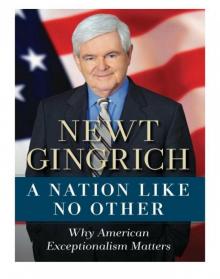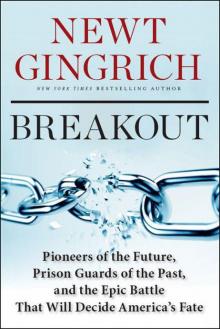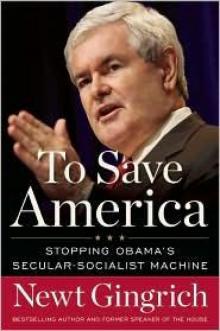- Home
- Newt Gingrich
Understanding Trump Page 12
Understanding Trump Read online
Page 12
Furthermore, Donald Trump was making an appeal based on identity as well—that of being an American. His patriotic call to make America great again overwhelmed explicit appeals to race, gender, and sexual orientation. This universal appeal based on broad issues and common culture trumped identity liberalism.
REFUSING TO LEARN THE LESSON OF THE TRUMP VICTORY
Immediately after the election, there was a lot of recrimination on the Left about what happened. In that environment, after such a shocking loss, there was an opportunity for the Left and the Democrats to reassess the usefulness of identity liberalism in building a stable governing coalition.
Mark Lilla, a college professor, wrote a widely shared piece in the New York Times called “The End of Identity Liberalism.” In it, he argued that the Left’s fixation on identity politics alienated the working class whose chief concern was economic anxiety. He called for a “post-identity liberalism” that would, like earlier successful liberal movements, appeal “to Americans as Americans and emphasize the issues that affect a vast majority of them.”21
In other words: do what Trump just did, only do it as Democrats.
One of the candidates for the role of DNC chairman in 2017 was more blunt, remarking that all Democrats offered in 2016 was a message of “How offensive!” and that the party needed to “grow up.” The candidate, Raymond Buckley, ultimately dropped out of the race.
Even President Obama, despite the fact that the party’s embrace of identity politics occurred during his presidency, offered this warning: “One message I do have for Democrats is that a strategy that’s just microtargeting particular, discrete groups in a Democratic coalition sometimes will win you elections, but it’s not going to win you the broad mandate that you need.”22
But within a few weeks of Obama’s warning, the Left reverted to form, insisting that identity liberalism was still the key to political success, and viciously attacking those who suggested otherwise. The fact is that identity liberalism is where all the energy is in their party, and any attempt to moderate this approach is met with fierce hostility.
Sally Boynton Brown, one of the candidates for chair of the Democratic National Committee, for example, said during a debate that the party must provide “training” for Americans on “how to shut their mouths if they are white.” She continued, saying that her job as a white woman was to “listen and be a voice and shut other white people down when they want to interrupt.”23
Steve Philips, a senior fellow at the liberal Center for American Progress, responded to Lilla, insisting that the party must not make the mistake of pursuing the votes of the “wrong white people”—by which he meant those who don’t subscribe to identity liberalism.
Even liberal darlings like Bernie Sanders are not spared the wrath of the liberal identity police.
Sanders’s surprising challenge to Hillary Clinton during the Democratic primary was partially due to his strength with white working-class voters.24 Sanders warned Democrats during his outsider primary campaign against Clinton that their party was losing touch with this key Democratic constituency. Ultimately, Clinton’s identity-politics-fueled campaign won the battle with Democrats and lost the war with everyone else.
After Donald Trump won the election by dominating among the working class in Midwestern states, you would think that the Democratic Party’s leaders might be open to taking Sanders’s warnings more seriously. “It is not good enough for someone to say, ‘I’m a woman! Vote for me!’ No, that’s not good enough,” Sanders said a few weeks after the election. “What we need is a woman who has the guts to stand up to Wall Street, to the insurance companies, to the drug companies.”
In response, a former Clinton operative responsible for minority outreach said, “I like US Senator Bernie Sanders but his comments regarding identity politics suggest he may be a white supremacist, too.”25
That’s right. Sanders, a Jewish socialist from liberal Vermont who spent his college years protesting discriminatory housing policy at the University of Chicago, is a white supremacist, according to the identity-obsessed Left.
These sorts of unhinged accusations are par for the course from advocates of identity politics. It’s not enough that you believe in equal rights for all people—you cannot acknowledge any other issues or suggest anything else is important.
It is clear that on the Left, broad-based economic liberalism has taken a back seat, and the universalist vision of the original civil rights movement based on American ideals has been repudiated.
The Democratic Party’s full-scale transformation into a cult of identity liberalism has changed the political discourse in America from a battle over ideas into a battle among identity groups. In this identity-obsessed environment, your political opponents aren’t just attacking your policy positions or theories, they are delegitimizing you as a person. No wonder so many college students demand safe spaces free from opposing viewpoints. They actually feel personally attacked because they see no difference between their political positions and their self-identity.
USA Today reported on November 15, 2016, that institutions of higher learning across the country were treating the results of the election the same way they typically treat tragedy.
Colleges and universities sponsored postelection recovery meetings, self-care events—and in the case of the University of Kansas, made therapy dogs available to students.
One of the more alarming reactions came from Boston University, where the dean of students sent an email telling students upset about the election to disengage. According to the newspaper, the email advised students:
“If you feel distressed by what is in the media, for the moment, limit your consumption of Facebook, Twitter and other social media sources that are likely to be full of distressing material,” reads one tip, curated by Boston University’s Dean of Students. “This also includes watching and reading the news. There are apps and websites such as LeechBlock, or SelfControl that can help you by temporarily blocking access to social media or certain websites.”
Universities are supposed to be preparing students for reality—not advising them to hide from it.
For younger Democratic activists, it will be very difficult for them to unlearn identity liberalism. The truth is, it is very seductive. People love talking about themselves, and identity liberalism’s focus on narrow subgroups of personal identity and niche issues allows its practitioners to turn inward to obsess over their own uniqueness and how they are personally affected by racism, classism, sexism, or whatever. And if you are constantly talking about yourself, you never bother to listen to anyone else.
Year after year, the American people have grown more and more alienated from the arrogance of the bureaucracies, the bullying of the elites, and the failure of the current system to work for them. Everywhere I went before Trump’s campaign, people were angry at Washington and frightened for their futures, their children’s futures, and their country’s future. Yet members of official Washington from both parties seemed wedded to business as usual. Then along came Trump. When Trump and I would talk about America’s leadership, with regard to trade in particular, Trump would repeat over and over, “They are just terrible negotiators. We got taken to the cleaners every time.” He was confident he could turn it around very quickly. After seeing him in action over the campaign, I was, too.
CHAPTER SEVEN
THE GREAT TRANSITION
Part of the reason Trump and his message were so successful in the 2016 election is that America is undergoing a Great Transition, and Trump was the only candidate who seemed aware of it.
Trump candidly expressed to the American people something politicians have willfully ignored for decades: most of our policy decisions—both in trade and defense—are based on a world that no longer exists. The era of the post–World War II, ultrarich America that faced little economic competition on the world stage is over.
Immediately following World War II, the United States had to help rebuild our trading par
tners in Europe. This initiative was called the Marshall Plan, and it provided roughly $12 billion to aid the recovery of Western Europe. For context, when you adjust for inflation, that’s about $162 billion in today’s currency1—four times the amount we currently spend on foreign aid. It was critical that we did so, because a war-torn, weakened Europe was a prime target for communism. Indeed, the Soviet Union rejected any aid under the Marshall Plan for the Eastern Bloc nations, because Stalin knew aid money from the United States would weaken Soviet influence in the region.
So, we helped rebuild Western Europe, and we separately sent millions of dollars in aid (which would be billions in today’s dollars) to a host of Asian countries, including Japan, China, and India, as well as Israel and several others. We could afford to do this because we had virtually no competition on the world stage. No other major developed country could compete with the United States economically, because their factories, their communities, their people—all their economic engines—had been bombed into oblivion.
Since then, the United States has framed its foreign aid and trade policies around the world I just described—the world as it was immediately after World War II. We have approached nearly all our foreign relations as the benevolent, wealthy, endlessly generous United States that can freely provide for the less fortunate of the world without a meaningful return. That was OK for the thirty-five years that followed the war. Our national debt stayed relatively flat until 1980, our production more than doubled in that time, and our debt as a percentage of our gross domestic product (GDP) had lowered from 118 percent in 1946 to about 32 percent. We were by an enormous margin the strongest economic power on the planet.
That started to change toward the end of the last century. The rebuilt world was waking up. Europe and Japan had recovered, China had seen decades of sustained growth and was on track to become the economic power it is today, and much of the rest of the world had prospered during the postwar recovery.
We made some adjustments to become more competitive. President Reagan’s agenda of lower taxes and less regulation succeeded in giving the US economy a boost, sparking a broad-based economic boom.
On trade, however, the United States continued to act as if it had no real competition—and by the end of the twentieth century, middle-class Americans began to be hit hard.
For decades, median household income tracked pretty closely with real GDP in the United States, according to economic data from the Federal Reserve Bank of Saint Louis. This meant that our country’s economic growth was benefiting everyone. That began to change in the late 1990s. Household income has essentially stayed flat since 1999 while GDP has increased by 20 percent. The economy is growing, but middle-class Americans do not benefit.
MAKE FREE TRADE FAIR AGAIN
The idea behind free trade is straightforward: if two or more countries that each specialize in making products the others can’t agree to trade those specific products without tariffs or taxes, then all the countries can benefit economically by exporting large amounts of their specialty products.
In theory, this is a good idea. What’s missing from the pro–free trade mantra is that all countries almost never benefit equally. The country that benefits the most in any trade agreement is the country that produces the most products that are highly desired by a majority of countries in the agreement.
For decades, that country was the United States. However, as globalization took hold, companies began opening factories in countries with much lower standards of living. If you only have to pay foreign workers a fraction of what you pay Americans, it becomes impossible to produce many types of goods in the United States at prices that are competitive.
It also only makes sense to enter agreements when we are buying products we actually need. It’s not a good deal for us if we are importing something we can already make at American facilities, with American workers.
IGNORED BY BOTH PARTIES
The impact of America’s Great Transition from being the world’s undisputed power and patron to being one of several self-interested nations competing on a global scale has largely been ignored by the elites in our government. This is partly due to mental inertia and partly due to the influence of entrenched special interests.
On the Left and Right, our politicians and bureaucrats have ignored the anxieties that have manifested themselves in the issues of trade and immigration, because raising alarms would divide their bases.
Large multinational companies with headquarters in America—which are active campaign donors to both sides—apply pressure on politicians because the companies benefit from free trade agreements.
President Trump has been crystal clear that his priority is seeing that American workers have jobs. The special interests of giant multinational corporations that benefit from open trade borders will no longer steer our trade policies from the shadows.
The industries argue that cheap labor and material costs available in other countries allow companies to produce and sell their products to Americans at lower prices, which means more money in American wallets.
This narrative ignores that when American companies outsource their labor or look for cheaper materials elsewhere, Americans lose jobs. What good is a cheaper widget if you don’t have the paycheck to buy it?
The “more in the wallet” argument also ignores something that Arthur C. Brooks, the president of the American Enterprise Institute, frequently writes about: long-term happiness comes from earned success, not handouts, deals, or even more money.
In op-eds Brooks wrote for the New York Times in 2013 and the Philadelphia Inquirer in 2014, he pointed out that studies show employment has a greater effect on happiness than income.
Citing the General Social Survey, a project of the independent research organization NORC at the University of Chicago that’s mainly funded by the National Science Foundation, Brooks says people who feel like their work is successful are two times more likely to say they are happy.
While income greatly affects the results of the survey for those who live in poverty, Brooks said that impact diminishes for people who make at least middle-class incomes.
“This is not about money. The secret to happiness through work is earned success—the belief you are creating value with your life and value in the lives of others,” Brooks writes.
While Brooks argued for policies that promote entrepreneurship in America—an important effort in its own right—the data also speak to the importance of prioritizing good-paying American jobs over getting lower prices at the cash register.
NAFTA: HINDSIGHT IS 20/20
A good example of the disconnect between the priorities of the American people and the large corporations who influence Washington is the North American Free Trade Agreement (NAFTA), which Trump early on called “single worst trade deal ever approved in this country.”
NAFTA was a free trade agreement the United States entered with Mexico and Canada. It was originally negotiated by President George H. W. Bush in 1992, but it wasn’t implemented until President Bill Clinton took office. Clinton added labor and environmental provisions before he brought it to Congress in 1993, but it was still widely supported by Republicans—including myself. In some ways, it represented the last gasp of that post–World War II America, and we in Congress either didn’t realize it or didn’t want to accept it.
I was the Republican whip during the NAFTA vote, and Republicans delivered more yes votes than Clinton and Gore could get on the Democratic side. Little did we realize back then that the time had come to shift from the post–World War II model of generosity to a more pro-American attitude.
We thought the cost to the United States would be minimal, and Mexico would gain jobs by exporting goods to the United States that we would otherwise buy from China. In fact, Mexico ended up taking jobs from us instead of China, and the difference in Mexican and American salaries was so great we were creating a flood of jobs out of the United States.
In 1994, when NAFTA was impleme
nted, the US per capita GDP was $27,776 in 1994 dollars, according to the World Bank. Canada’s GDP at the time was $19,859 per capita, so this wasn’t a huge difference. But Mexico’s 1994 per capita GDP was $5,690.2 Added to that, the main US industries affected by the removal of tariffs on Mexican and Canadian products in NAFTA were auto manufacturing, textiles, and agriculture—all things the United States does very well.
According to the US Bureau of Labor Statistics, the overall number of manufacturing jobs in the U.S. has declined from 17.7 million in 1993 to 12.2 million today. Automotive jobs dropped from 1.1 million to 944,600 and textile jobs went from 836,500 to a mere 128,900 today.3 NAFTA isn’t solely responsible for that. Automation caused many of the job losses in the automotive industry—but NAFTA didn’t help.
At the same time, thanks to NAFTA, the automotive industry in Mexico has exploded. According to a 2014 paper by the Wharton School—Trump’s alma mater—Mexican automotive exports to the United States have substantially increased.4
As recently as 2008, Japan exported almost twice as many cars to the United States as did Mexico. This year, however, Mexico will export 1.69 million vehicles to the U.S., surpassing the 1.51 million vehicles exported by Japan to the same market. By 2015, Mexico will export 1.9 million vehicles to the U.S., surpassing Canada as the largest exporter to the U.S.

 1945
1945 Collusion
Collusion Trump's America
Trump's America Shakedown
Shakedown A Nation Like No Other
A Nation Like No Other To Try Men's Souls - George Washington 1
To Try Men's Souls - George Washington 1 Pearl Harbor: A Novel of December 8th
Pearl Harbor: A Novel of December 8th Valley Forge: George Washington and the Crucible of Victory
Valley Forge: George Washington and the Crucible of Victory To Save America
To Save America Grant Comes East cw-2
Grant Comes East cw-2 Victory at Yorktown: A Novel
Victory at Yorktown: A Novel Days of Infamy
Days of Infamy The Battle of the Crater: A Novel (George Washington Series)
The Battle of the Crater: A Novel (George Washington Series) Breakout: Pioneers of the Future, Prison Guards of the Past, and the Epic Battle That Will Decide America's Fate
Breakout: Pioneers of the Future, Prison Guards of the Past, and the Epic Battle That Will Decide America's Fate Pearl Harbour and Days of Infamy
Pearl Harbour and Days of Infamy Pearl Harbour - A novel of December 8th
Pearl Harbour - A novel of December 8th Understanding Trump
Understanding Trump To Save America: Abolishing Obama's Socialist State and Restoring Our Unique American Way
To Save America: Abolishing Obama's Socialist State and Restoring Our Unique American Way